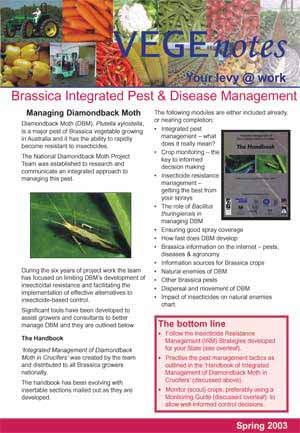|
Integrated Pest Management (IPM)
helps growers select the best tool to manage
pests.
Moth
Diamondback Moth (DBM), Plutella xylostella,
is a major pest of Brassica vegetable growing
in Australia and it has the ability to rapidly
become resistant to insecticides.
The National Diamondback Moth Project
Team was established to research and
communicate an integrated approach to
managing this pest.
During the six years of project work the team
has focused on limiting DBM’s development of
insecticidal resistance and facilitating the
implementation of effective alternatives to
insecticide-based control.
Significant tools have been developed to
assist growers and consultants to better
manage DBM.
Clubroot, caused by the organism Plasmodiophora brassicae, affects crucifer plants including broccoli, cauliflower, Chinese cabbage, Brussels sprouts, bok choy, cabbage, Swedes, radish and turnips. It can also persist in cruciferous weeds (eg wild turnip and wild radish).
Symptoms include wilting of plants during warm weather and the formation of enlarged galls on the roots. The galls prevent the uptake of water and nutrients, reducing the potential yield of the crop.
Integrated management of clubroot aims to achieve a soil environment that ensures the spore population remains below the threshold required for the disease. This is best achieved using a combination of management techniques.


- Improve hygiene – Spores can be transported by anything
carrying soil or water including machinery,
shared/contract labour and equipment, boots,
livestock, pallets, transplants and dams
receiving run-off from affected paddocks.
- Modify the soil Environmental factors can be managed to create
soil conditions that restrict disease development.
• Clubroot is less virulent in high pH soil. Apply
lime to maintain a soil pH of 7.0 – 7.5.
• Calcium and boron affect the growth and
reproduction of clubroot and application should
occur at transplanting and during the first four
weeks of the life of the crop, to protect the
vulnerable roots.
• Clubroot requires free water to assist with
movement through the soil. Improve
drainage by using raised beds for cropping or
laser grading low lying areas. Avoid
overwatering.
- Rotate crops
Increase the duration between successive
brassica crops to allow natural decay of the
spores. Rotate with non-brassica crops and
maintain crops free of cruciferous weeds.
Chinese cabbage is most susceptible to clubroot,
followed by cauliflower, cabbage and broccoli.
However, some cultivars within a species are
tolerant
- Use fungicides wisely Application of fungicide may also be necessary in
paddocks with previously high levels of disease.
It is important to evenly distribute fungicides
around the transplant root zone.
This is best achieved by incorporating the
fungicide into the transplant row at planting.
- Know the disease risk Effective on farm application of integrated
management techniques will require some
estimation of likely disease risk and will depend
on:
• Sowing time
• Soil type
• Drainage
• soil pH,
• crop – including variety
• cruciferous weed hosts
|

